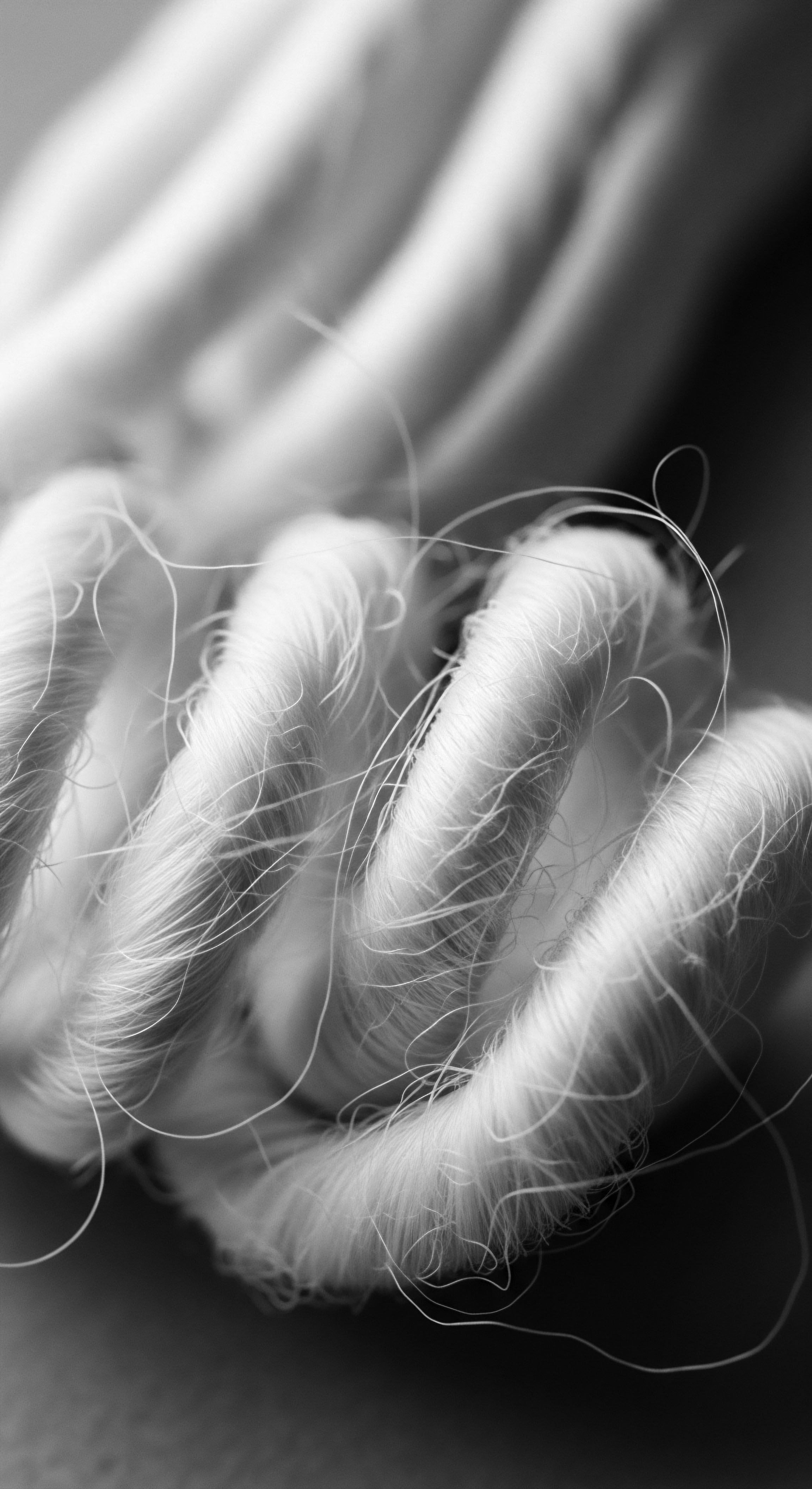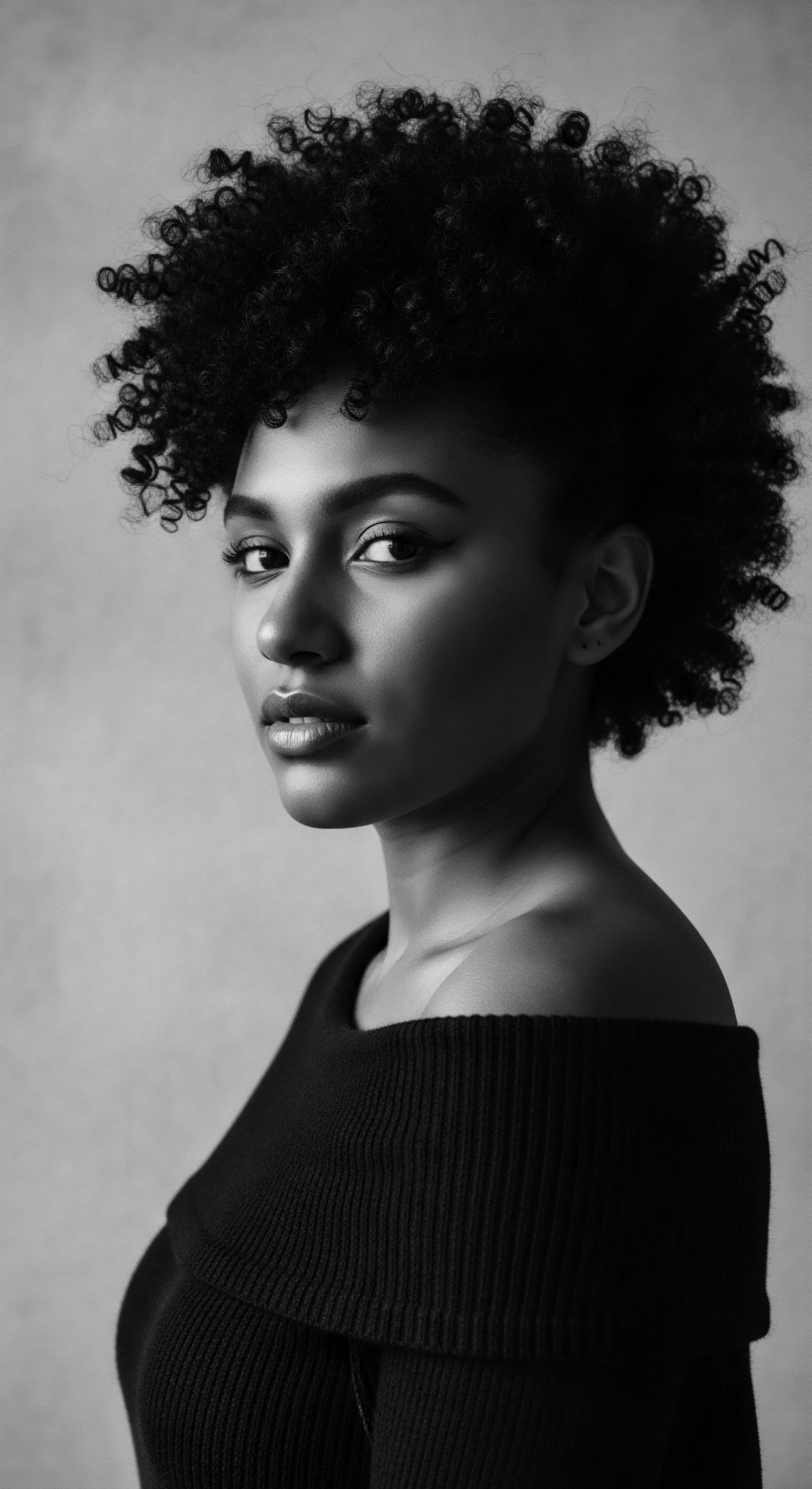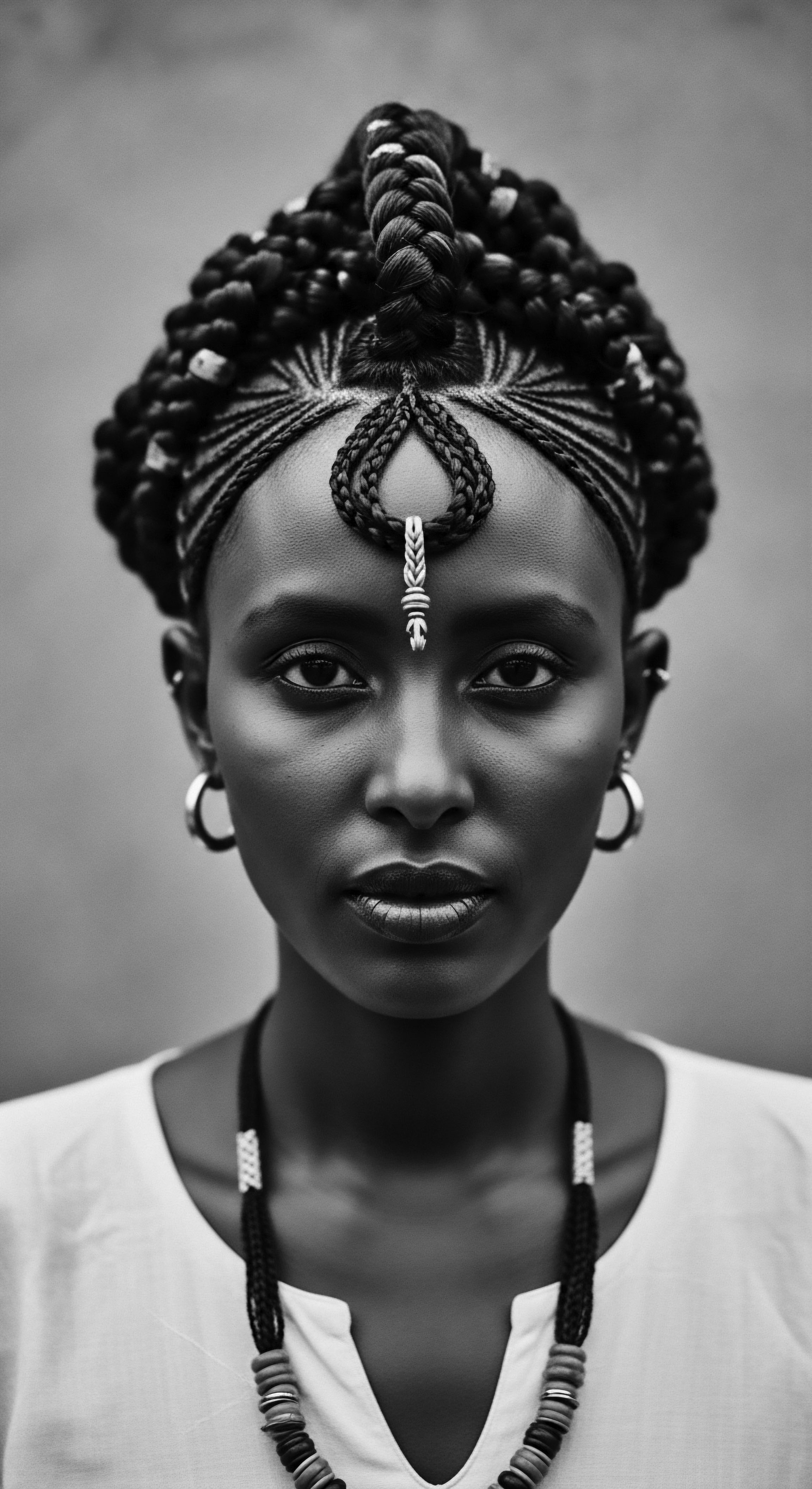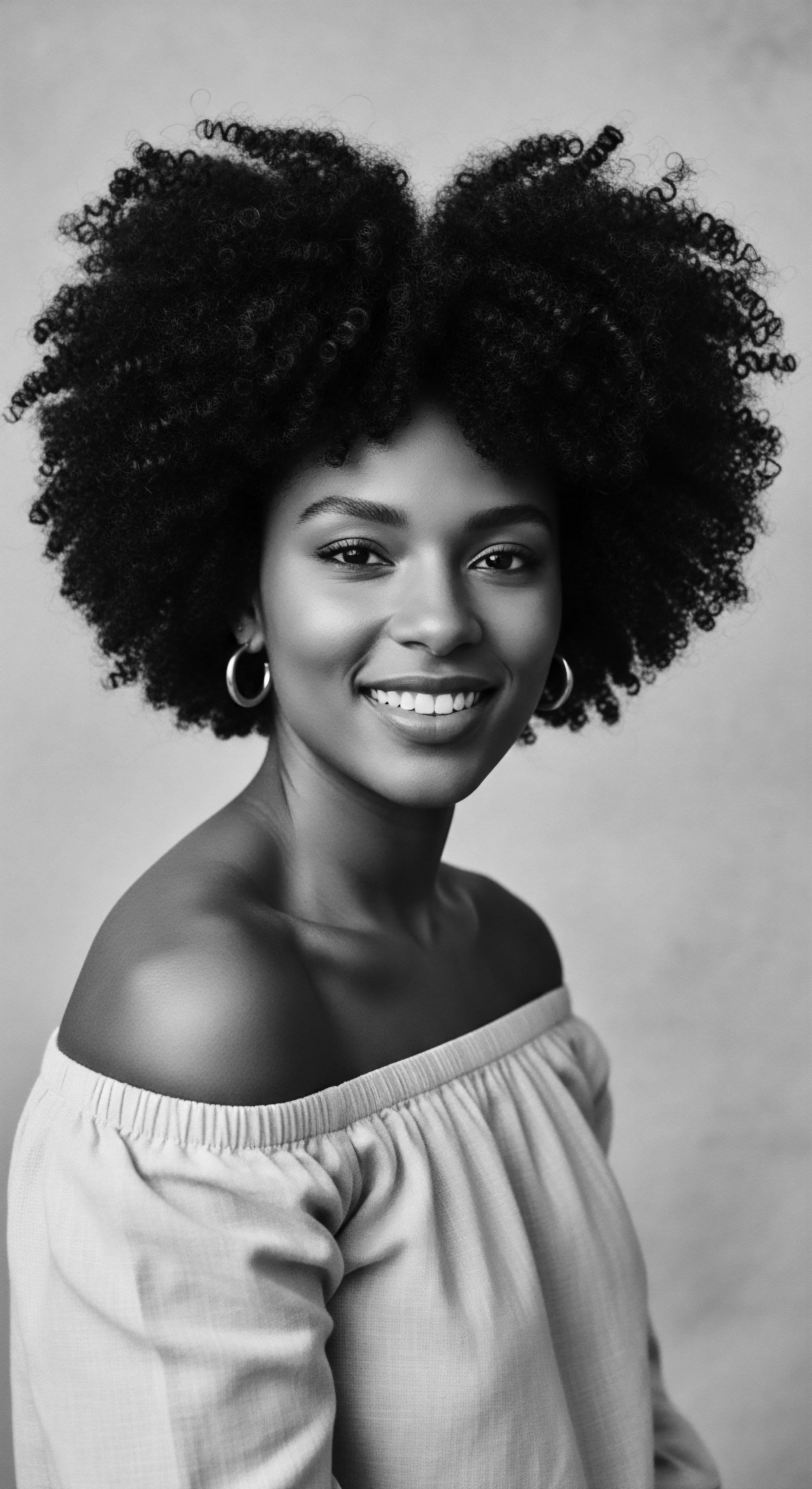
Fundamentals
The concept of Sustainable Beauty, within the sacred context of textured hair heritage, signifies a mindful approach to hair care that respects the intricate relationship between human well-being, cultural legacy, and the natural world. It is a philosophy that extends beyond mere product choices, encompassing the entire cycle of creation, use, and eventual return to the earth, all while honoring the ancestral practices that have long sustained hair health and cultural identity. For those new to this perspective, understanding Sustainable Beauty begins with recognizing hair not simply as an aesthetic adornment, but as a living extension of self, a carrier of history, and a conduit of generational wisdom.
This initial delineation of Sustainable Beauty emphasizes practices that are inherently restorative and non-extractive. It points towards a return to ingredients and methods that have been proven over centuries within Black and mixed-race communities, reflecting an innate understanding of environmental balance and personal vitality. Such an approach suggests that true beauty flourishes when it is in alignment with the rhythms of nature and the deep-seated knowledge passed down through families. It is about fostering a connection to the earth and to one’s roots, ensuring that beauty rituals contribute to the health of both the individual and the planet.
Sustainable Beauty, in its simplest form, is a conscious return to hair care practices that honor ancestral wisdom, ecological balance, and personal well-being.

Echoes from the Source ❉ Traditional Ingredients and Practices
The earliest forms of Sustainable Beauty for textured hair were not labeled as such; they were simply life. Communities across Africa and its diaspora utilized local botanicals, natural clays, and nourishing oils, understanding their properties through generations of observation and practice. These elemental resources were often abundant, easily renewable, and processed with minimal impact, reflecting an intrinsic harmony with their environment. The application of these natural elements fostered hair health without depleting resources or introducing harsh substances.
Consider the widespread historical use of shea butter, extracted from the nuts of the shea tree indigenous to West Africa. This rich, emollient substance, packed with vitamins and fatty acids, has served for centuries as a natural moisturizer and protectant for both skin and hair. Its production, often a communal endeavor, supports local economies and encourages the preservation of the shea tree, exemplifying a circular, sustainable system.
Similarly, African black soap, crafted from plantain skins, palm leaves, and cocoa pods, offers a gentle yet effective cleansing that is entirely biodegradable. These examples underscore how ancestral practices inherently embodied the principles of Sustainable Beauty long before the term was coined.
The understanding of Sustainable Beauty also involves appreciating the meticulousness and intention behind traditional hair care. It was not a rushed affair, but a communal ritual, often performed by elders, teaching younger generations the delicate art of detangling, moisturizing, and styling. This intergenerational transfer of knowledge ensured that practices were passed down, adapted, and preserved, creating a sustainable lineage of care.
| Ancestral Practice (Heritage Focus) Communal Preparation of Botanicals (e.g. grinding herbs for hair masks) |
| Modern Sustainable Equivalent/Insight Ethical Sourcing and Fair Trade Partnerships with Indigenous Communities |
| Ancestral Practice (Heritage Focus) Water-Conscious Cleansing (e.g. rinsing hair in shared basins, using less water) |
| Modern Sustainable Equivalent/Insight Water-Saving Showerheads and Shorter Wash Routines |
| Ancestral Practice (Heritage Focus) Air-Drying Hair (relying on natural evaporation) |
| Modern Sustainable Equivalent/Insight Minimizing Heat Styling to Reduce Energy Consumption |
| Ancestral Practice (Heritage Focus) Multi-Purpose Natural Ingredients (e.g. shea butter for hair, skin, cooking) |
| Modern Sustainable Equivalent/Insight Multi-Functional Products with Minimal Ingredients and Packaging |
| Ancestral Practice (Heritage Focus) The enduring wisdom of ancestral methods provides a profound blueprint for contemporary sustainable beauty, emphasizing reverence for natural resources and communal well-being. |

Intermediate
Expanding upon the foundational understanding, the intermediate meaning of Sustainable Beauty for textured hair delves into its systemic and cultural implications. It recognizes that true sustainability extends beyond ingredient lists to encompass the entire value chain, the economic empowerment of communities, and the reclamation of cultural identity through hair. This perspective acknowledges that for Black and mixed-race individuals, hair has always been a powerful marker of identity, resistance, and connection to heritage, often subjected to oppressive beauty standards. Therefore, Sustainable Beauty, in this context, is inextricably linked to social justice and the dismantling of colonial beauty ideals.
The focus here shifts to how the choices made in hair care can actively support ecological regeneration and cultural preservation. It involves scrutinizing the origins of ingredients, the labor practices involved in their production, and the overall environmental footprint of beauty rituals. This deeper comprehension of Sustainable Beauty requires a critical lens, moving beyond surface-level “greenwashing” to genuinely support systems that are equitable and regenerative for both people and the planet.

The Tender Thread ❉ Living Traditions of Care and Community
Within the vibrant tapestry of textured hair heritage, Sustainable Beauty finds its most potent expression in the living traditions of care and community. These are the practices that have sustained generations, not only through the efficacy of natural remedies but also through the profound communal bonds they fostered. The act of hair care, whether braiding, oiling, or styling, often served as a sacred space for storytelling, mentorship, and the transmission of cultural knowledge.
Consider the intricate braiding traditions of various African communities, where patterns could signify marital status, age, or tribal affiliation. These styles, while aesthetically significant, were also practical, protecting the hair from environmental elements and promoting length retention. The materials used for extensions or adornments were often natural fibers or locally sourced beads, ensuring a minimal ecological impact. This inherent understanding of longevity and resourcefulness speaks volumes about the deep-seated sustainability within these practices.
Sustainable Beauty is a commitment to practices that honor the sacred intergenerational transfer of knowledge and resources, ensuring hair health and cultural vitality for future generations.
The rise of the natural hair movement in the 20th and 21st centuries, a resurgence rooted in the “Black Is Beautiful” ethos of the 1960s, serves as a contemporary example of Sustainable Beauty in action. This movement encouraged individuals to embrace their natural hair textures, moving away from chemical relaxers and heat styling that often caused damage and contributed to environmental waste. This shift represents a collective decision to prioritize health, identity, and environmental responsibility over conformity to Eurocentric beauty standards. The conscious rejection of harmful chemicals, many of which pose risks to both human health and aquatic ecosystems, underscores a vital aspect of this sustainability.

Ancestral Botanicals and Their Enduring Significance
Many ancestral botanicals continue to hold profound significance in modern sustainable beauty. Their continued use is a testament to their efficacy and the deep knowledge held within traditional systems.
- Shea Butter ❉ Beyond its moisturizing properties, shea butter production often supports women’s cooperatives in West Africa, creating a sustainable economic model that benefits communities directly.
- Coconut Oil ❉ Widely used across various diasporic communities, its cultivation can be sustainable when practiced through regenerative farming, providing nourishment for hair and livelihoods for growers.
- Aloe Vera ❉ A succulent plant known for its soothing and hydrating qualities, aloe vera is easily cultivated and provides a gentle, effective base for many hair preparations.
These ingredients, when sourced responsibly, offer a tangible connection to the earth and to the ancestral practices that understood their inherent value. Their use represents a conscious choice to support ecological health and community well-being, embodying the principles of Sustainable Beauty.

Academic
The academic delineation of Sustainable Beauty, particularly when viewed through the lens of textured hair heritage, is not merely an explanation; it is a profound philosophical and scientific inquiry into the interconnectedness of human well-being, cultural continuity, and ecological integrity. It is a critical interpretation that posits Sustainable Beauty as a regenerative paradigm, one that actively repairs historical harms while fostering resilient futures. This perspective moves beyond a simple definition to examine the complex interplay of biological realities, socio-cultural constructs, and economic systems that have shaped hair practices across the African diaspora. It asserts that true Sustainable Beauty is a commitment to decolonizing beauty standards, valuing ancestral ecological knowledge, and promoting practices that are restorative on every level—from the molecular structure of the hair strand to the global supply chains of ingredients.
This meaning of Sustainable Beauty necessitates a deep understanding of the inherent biological structure of Afro-textured hair, which, through evolutionary adaptation, developed unique properties to protect early human ancestors from intense ultraviolet radiation. Its distinct coiling patterns, density, and moisture retention characteristics require specific care methodologies that traditional practices intuitively understood and optimized. The modern scientific understanding of hair biology now often validates these long-standing ancestral methods, revealing a sophisticated, empirical knowledge base that was passed down through generations.

The Unbound Helix ❉ Voicing Identity and Shaping Futures
The journey of textured hair through history is a powerful testament to its capacity to voice identity and shape futures, often in the face of immense pressure. This historical context reveals how hair, beyond its biological reality, became a battleground for self-determination and cultural preservation. The imposition of Eurocentric beauty ideals during periods of colonialism and slavery led to the systematic denigration of Afro-textured hair, compelling many to adopt practices that altered their natural curl patterns. This cultural suppression, however, often spurred resistance, with hair becoming a visible symbol of defiance and pride.
A particularly compelling case study that illuminates the profound connection between Sustainable Beauty and textured hair heritage is the enduring practice of using Chebe Powder by the Basara women of Chad. This ancient ritual, passed down through generations, exemplifies a deeply sustainable approach to hair care that prioritizes natural ingredients, minimal processing, and community knowledge. Chebe powder, a blend of local botanicals including shébé seeds, mahllaba soubiane seeds, missic stone, cloves, and samour resin, is traditionally mixed with water or oil and applied to the hair lengths, avoiding the scalp. This practice, rigorously maintained, has been credited with the Basara women’s ability to retain remarkable hair length, often reaching waist-length, despite the arid desert environment.
From an academic perspective, the Chebe practice demonstrates a sophisticated understanding of hair biology and sustainable resource management. The ingredients are locally sourced, requiring no distant transportation or complex manufacturing. Their preparation is artisanal, preserving the integrity of the botanicals. The method of application focuses on strengthening the hair shaft and minimizing breakage, which aligns with modern trichological principles of length retention.
This tradition is not merely about aesthetics; it is an embodiment of a living library of ecological wisdom, passed through an unbroken chain of intergenerational learning. Research into such traditional practices, though often scarce in formal academic literature, provides invaluable insights into effective, sustainable hair care methodologies that predate industrial beauty complexes. Ethnobotanical studies, such as those exploring African plants for hair treatment, underscore the richness of this traditional knowledge, often revealing how communities intuitively understood the properties of botanicals for hair health and growth.
The sustained use of Chebe powder, therefore, offers a counter-narrative to the dominant industrial beauty model, which often relies on synthetic compounds, extensive packaging, and rapid consumption cycles. It presents a powerful example of how communities can maintain vibrant beauty practices that are intrinsically sustainable, culturally resonant, and scientifically sound, even if the science was understood through centuries of observation rather than laboratory analysis. The persistence of such traditions speaks to their efficacy and the deep cultural meaning embedded within them.

Reclaiming Agency ❉ Hair as a Site of Environmental and Social Justice
The academic discourse on Sustainable Beauty for textured hair cannot be separated from its role in environmental and social justice. The historical subjugation of Black hair, often deemed “unprofessional” or “unruly,” has had tangible consequences, pushing individuals towards chemical straightening agents that pose significant health risks and environmental burdens. These chemical relaxers, containing ingredients like formaldehyde and phthalates, contribute to water contamination and landfill waste, creating a clear intersection between racialized beauty standards and ecological harm.
The ongoing natural hair movement, therefore, represents a collective act of environmental justice, as individuals choose to minimize exposure to harmful chemicals and reduce their ecological footprint. It is a reassertion of agency, a declaration that beauty does not require conformity to external standards, nor does it necessitate compromising the health of the individual or the planet. This shift fosters a profound sense of self-acceptance and pride, aligning personal well-being with broader ecological principles.
The definition of Sustainable Beauty at this academic level is thus ❉ a comprehensive, culturally informed, and ecologically responsible framework for hair care that honors the ancestral wisdom and biological distinctiveness of textured hair, promotes the equitable sourcing of natural resources, and fosters intergenerational knowledge transfer, all while actively resisting colonial beauty paradigms and advocating for environmental and social justice within the beauty industry. This multi-dimensional meaning recognizes that the pursuit of beauty can and must be a force for holistic well-being and planetary regeneration.
To further illustrate the intricate connections between ancestral practices and contemporary understanding of Sustainable Beauty, consider the evolution of hair care tools and rituals:
- Combs and Styling Tools ❉ Traditional African combs, often carved from wood or bone, were designed to navigate the unique coiling patterns of textured hair, minimizing breakage. These tools were durable, often passed down through families, embodying a sustainable approach to utility. Modern sustainable beauty seeks similar longevity and biodegradable materials, moving away from disposable plastic.
- Protective Styling ❉ Styles like braids, twists, and cornrows, deeply rooted in African heritage, served not only aesthetic and social functions but also protected the hair from environmental damage, reducing the need for frequent manipulation or chemical treatments. This inherent protective quality is a cornerstone of sustainable hair care.
- Ritualistic Application ❉ The careful, often communal, application of oils, butters, and herbal infusions was a slow, intentional process, allowing ingredients to deeply penetrate and nourish the hair. This contrasts sharply with the hurried, often excessive, application of multiple products in modern routines, many of which are designed for rapid consumption.
This academic lens allows us to see that the practices of Sustainable Beauty are not novel inventions but rather a return to, and an elevation of, wisdom that has existed within textured hair communities for millennia.

Reflection on the Heritage of Sustainable Beauty
As we conclude this exploration of Sustainable Beauty, a profound sense of reverence settles upon the enduring heritage of textured hair. It becomes clear that this concept is not a fleeting trend, but a timeless wisdom, deeply inscribed within the very Soul of a Strand. The journey from elemental biology to the vibrant expressions of identity, through the tender threads of community care, reveals a continuous narrative of resilience, ingenuity, and profound connection to the earth. Ancestral practices, once simply ways of life, now stand as beacons, illuminating a path toward a future where beauty rituals are truly regenerative.
The heritage of textured hair, with its unique biology and rich cultural narratives, offers an unparalleled blueprint for what Sustainable Beauty truly means. It speaks of a time when beauty was not extracted or manufactured, but cultivated with patience, respect, and a deep understanding of natural cycles. The stories embedded in each coil and kink remind us that hair is more than protein; it is a living archive, holding the echoes of generations who nurtured it with intention and knowledge. This wisdom, passed from hand to hand, generation to generation, forms the bedrock of a beauty philosophy that honors the past, enriches the present, and safeguards the future.
To embrace Sustainable Beauty is to listen to these echoes, to learn from the tender threads of tradition, and to allow the unbound helix of our hair to voice its authentic story. It is a call to recognize the inherent value in every strand, acknowledging its journey through time and its profound connection to our collective heritage. In doing so, we not only nurture our hair but also contribute to a larger movement of healing—for ourselves, our communities, and the very planet that sustains us. This understanding beckons us to step into a future where beauty is not merely seen but felt, a vibrant testament to enduring legacy and mindful stewardship.

References
- Caffrey, C. (2023). Afro-textured hair. EBSCO Research Starters.
- Henderson, A. (2015). Redefining the Identity of Black Women ❉ “Natural” Hair and the Natural Hair Movement. George Washington University.
- Lashley, M. (2021). The importance of hair in the identity of Black people. Journal of Black Studies, 52(2), 143-162.
- Rajan-Rankin, S. (2022). Material Intimacies and Black Hair Practice ❉ Touch, Texture, Resistance. Journal of Black Studies, 53(1), 3-20.
- Rosado, S. (2003). The grammar of hair ❉ A semiotic analysis of hair and hairstyles among women of African descent in the United States. ProQuest Dissertations Publishing.
- Thompson, C. (2009). Hair story ❉ Untangling the roots of Black hair in America. St. Martin’s Press.
- Vyas, S. Gupta, K. Modi, P. & Bhadee, A. (2018). Chemical relaxers and curlers ❉ Hidden danger. Indian Journal of Clinical and Experimental Dermatology, 4(4), 331-334.
- Wang, J. & Lin, C. (2019). Hair relaxers ❉ Innovation, sustainability and formulation. White Rose Research Online.
- McDonald, C. (2021). Girls and Women Exploring Intergenerational Learning Through Storytelling. MSVU e-Commons.
- Nchinech, N. Boujja, F. Hami, H. & El Hamzaoui, N. (2023). Plants Use in the Care and Management of Afro-Textured Hair ❉ A Survey of 100 Participants. Scholars Journal of Applied Medical Sciences, 11(11), 1984-1988.
- Olu, E. (2022). An Age-Old African Hair Care Tradition May Help You Retain More Length. Sisters from AARP.
- Aemmi, S. Z. & Karimi Moonaghi, H. (2016). Intergenerational Learning Program ❉ A Bridge Between Generations. International Journal of Community Based Nursing and Midwifery, 4(4), 266-276.
- Mboumba, S. A. & Kapele, M. B. (2024). Cosmetopoeia of African Plants in Hair Treatment and Care ❉ Topical Nutrition and the Antidiabetic Connection? Diversity, 16(2), 96.
- Alami, H. Elachouri, M. & Amrani, S. (2017). Ethnobotanical Survey of Medicinal Plants used in the Treatment and Care of Hair in Karia ba Mohamed (Northern Morocco). Journal of Applied Biology & Biotechnology, 5(05), 036-042.
- Okeke, O. C. Okonkwo, O. O. & Akpan, M. E. (2024). Cosmetic Ethnobotany Used by Tribal Women in Epe Communities of Lagos State, Nigeria. Juniper Publishers.
